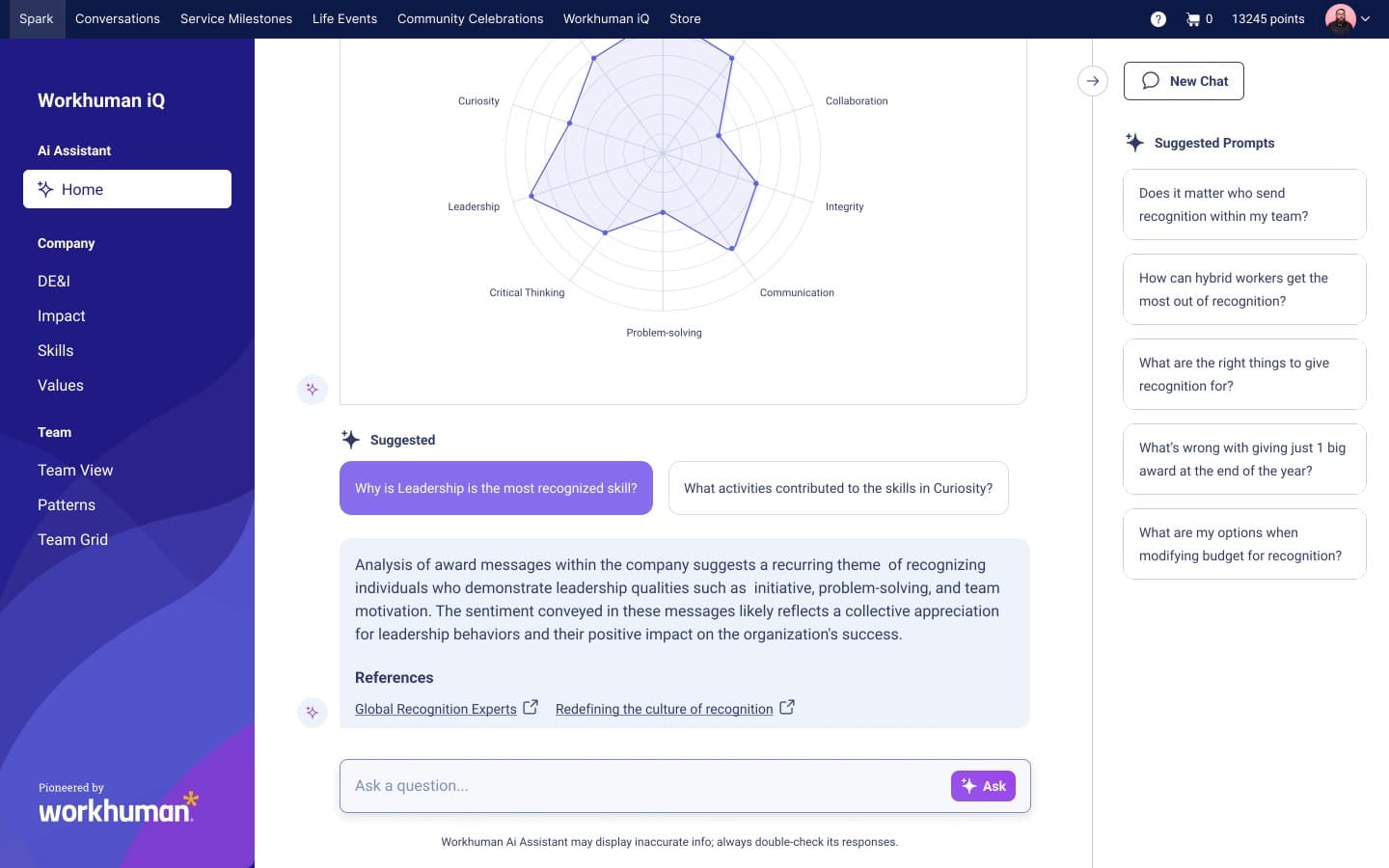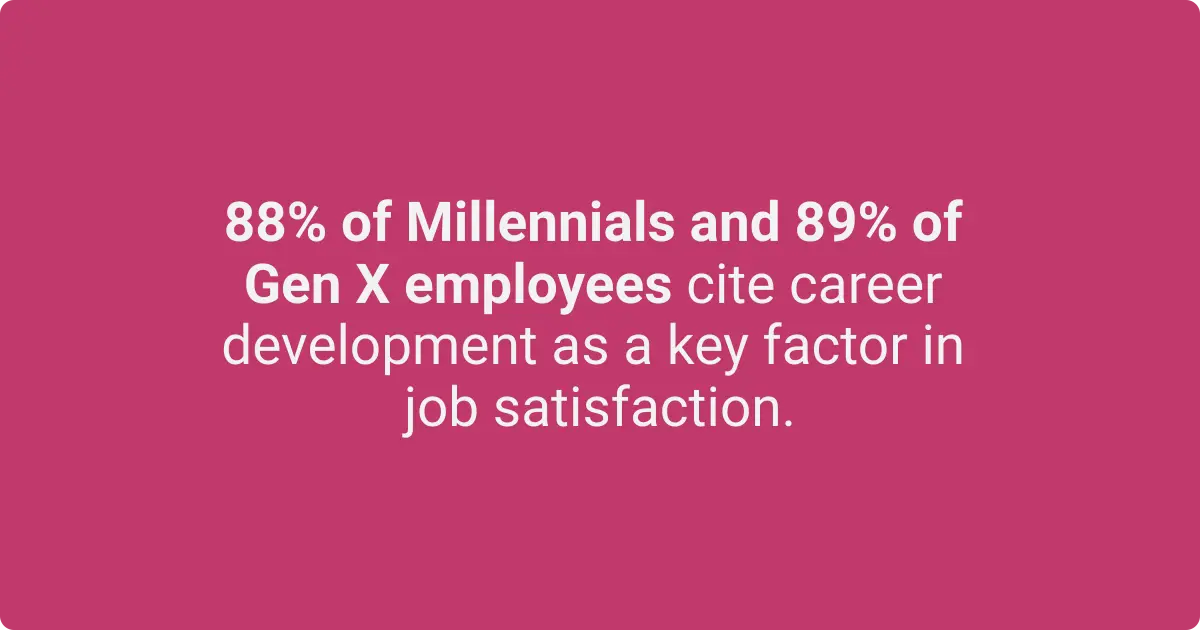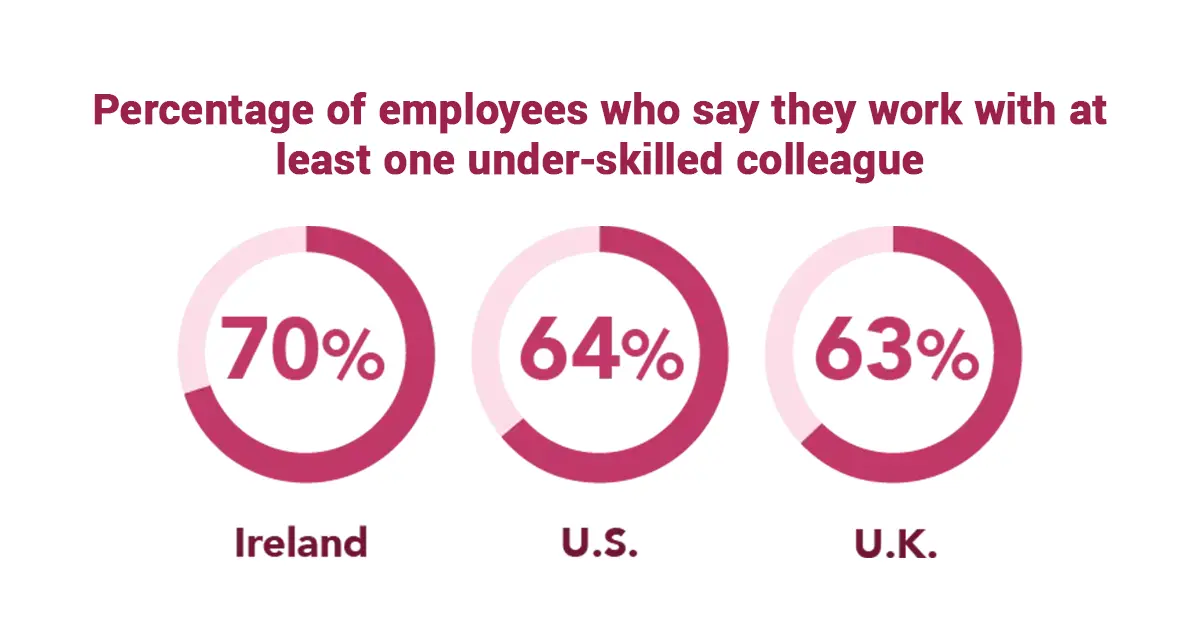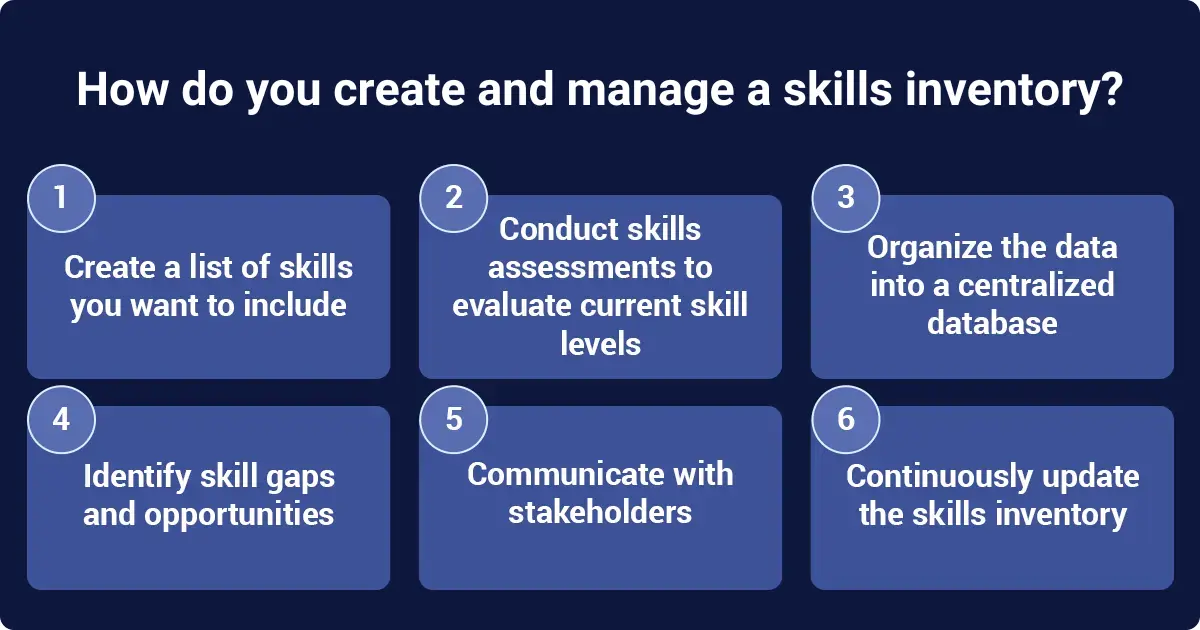How a Skills Inventory Drives Business Success

Creating a skills inventory is like assembling your organization’s Swiss Army Knife - versatile, practical, and invaluable. Imagine having a detailed audit of all the skills within your team at your fingertips.
This is not just about counting heads; it’s about understanding your workforce's hidden strengths and potential, enabling data-driven decisions that can propel your organization to new heights.
A skills inventory helps identify gaps in employees' skills and provide appropriate training. By systematically tracking your employees' competencies, you can pinpoint areas that need development and leverage existing talents for strategic projects.
Think of it as turning your organization into a well-tuned orchestra, where each instrument (or employee) plays a crucial role in achieving harmony and success. A comprehensive skills inventory can be the cornerstone of informed strategic planning, fostering growth, and ensuring that you have the right skills in the right places.
Imagine looking at your team and seeing not just their current roles but all the possible moves on the chessboard. That’s the strategic importance of a skills inventory – it provides a panoramic view from 30,000 feet, allowing you to navigate challenges and seize opportunities confidently.
So, why not get ahead of the curve and make your organization’s skill set your secret weapon for success?
What is a skills inventory?
A skills inventory is a comprehensive database that lists the skills, qualifications, and competencies of an organization's employees.
A skills inventory is an internal database that documents your employees' talents, experiences, and education. It's a powerful tool for understanding your team's strengths and strategically optimizing your workforce. By leveraging this data, you can make informed decisions that drive efficiency and growth.
Skills inventories typically include:
- Skills: Technical abilities, hard and soft skills, certifications.
- Education: Degrees, specialized training, workshops.
- Experience: Job history, project involvement, accomplishments.
- Capabilities: Competency levels, linguistic abilities, leadership potential.
This data is essential for a variety of reasons. When you’re hiring new talent, it helps identify exactly what skills you need to complement your existing team. During project planning, you can quickly conduct a skills gap analysis to determine if you have the right mix of skills or need to address any gaps.
Unlike a skills assessment, which evaluates proficiency in particular areas, a skills inventory is like having your workforce’s résumé at your fingertips. It’s about capturing the full picture of each employee's capabilities. This clarity aids workforce optimization by ensuring you deploy the right talents for the right tasks.
Maintaining an updated skills inventory is vital. Regular updates keep the information accurate, allowing you to navigate challenges and seize new opportunities effectively. In short, it's your key to maximizing your team's potential and ensuring they are always ready for what's next.
By leveraging a skills inventory, you can strategically steer your organization towards success, whether expanding your team, running intricate projects, or getting ahead of market changes.
You might also like: What is a Skills Profile and Why Do They Matter?
The Workhuman iQ team of data scientists and linguists developed a recognition-specific language model so you can see skills employees recognize in each other.
Map skills and shape development across your company with insight and guidance from Workhuman's newAI AssistantOpens in a new tab.

What are the benefits of skills inventories?
Creating and maintaining a skills inventory, or mapping skills across your workforce, offers several benefits for organizations. From aiding in employee development to enhancing overall efficiency, the advantages translate into sustainable growth and productivity.
A skills inventory is also crucial for strategic HR planning, bringing order to chaos and providing value to HR professionals and resource managers.
1. Enhancing employee development and career growth
A skills inventory serves as a treasure trove for HR professionals, spotlighting areas where employees excel and areas ripe for development. Evaluating and tracking employees' skills through such an inventory can reveal hidden talents and provide development opportunities.

Career paths become more apparent, and employees are more likely to seek training and development opportunities that align with their newfound strengths. It’s a win-win: employees grow, and the organization nurtures promising talent.
2. Improving organizational efficiency and project allocation
A skills inventory ensures that specific projects are handled by the right people. HR professionals and team leaders can allocate tasks efficiently, reducing downtime and maximizing productivity.
For instance, knowing which employee excels in data analytics can come in handy when a data-heavy project pops up. That way, projects are executed more smoothly, and bottlenecks are minimized.
3. Facilitating strategic workforce and succession planning
Strategic workforce planning is no walk in the park without data. Enter the skills inventory, the roadmap to help HR professionals plan future needs and potential hirings with precision.
By having a documented list of employee skills, organizations can predict the need for recruitment well in advance. This makes future workforce adjustments and talent acquisitions more streamlined and effective. Skills inventories also support strategic planning efforts by assessing the existing talent pool.
4. Helps in identifying skill gaps
A skills inventory serves as the organizational crystal ball, revealing an employee's skill level and identifying skill gaps. The absence of necessary skills can be pinpointed swiftly, allowing decision-makers to address these gaps before they become larger issues.

For example, if you discover a shortage in cybersecurity expertise across your teams, this is your cue to either upskill existing employees or bring in new talent. Considering that 64% of employees report working with at least one under-skilled colleague, proactively addressing skill gaps is crucial to keeping the organization current and competitive.
5. Improves employee engagement
Nothing says “we care”, like investing in employee development and career growth. By maintaining a skills inventory, you signal to your team that their personal and professional development matters.
Employees feel valued when their skills are acknowledged and harnessed, increasing job satisfaction and engagement. An engaged workforce is more motivated and less likely to jump ship, leading to lower turnover rates.
Learn how acknowledging and harnessing your employees' skills can cut your employee turnover in half and save up to $16.1M annually. Check out this guide.
6. Helps in planning upskilling and reskilling initiatives
The modern workplace is perpetually evolving, and keeping skills up to date is crucial. With a skills inventory, planning, upskilling, and reskilling become a calculated move rather than a shot in the dark.
Identify employees who need specific training to meet the demands of new projects or technologies. This structured approach helps roll out targeted employee development programs that hit the mark every time.
Learn more about effective reskilling strategies with AI-powered platforms and how to maintain a competitive edge in today's dynamic workplace.
7. Enables smoother internal mobility
Picture this: an in-house designer with a hidden talent for project management. A skills inventory makes such internal talent more visible, recognizing and nurturing it for internal mobility.
When employees are aware of internal opportunities that fit their skills, they are more inclined to move within the organization rather than seek external opportunities. This not only aids in retention but also ensures that talent remains within the company, adding value in diverse roles.
How do you create and manage a skills inventory?
Creating and managing a skills inventory involves several key steps, from defining essential skills for success to regularly updating the inventory. Emphasis is placed on assessing employee competencies, identifying gaps, and effectively communicating with stakeholders.
A skills inventory is also essential for succession planning, as it helps identify potential candidates for future management roles and bridge any skill gaps.
Create a list of skills you want to include
Start by identifying the skills that are in demand and critical to your organization. Divide these into technical skills, soft skills, competencies, educational background, and job-related experiences. Engage various departments to ensure nothing is overlooked. Creating a detailed and comprehensive list is vital to ensure the skills inventory’s effectiveness.
Here’s a quick list you might consider:
- Programming languages (e.g., Python, Java)
- Communication abilities
- Project management experience
- Leadership qualities
- Specific certifications or degrees
Conduct skills assessments to evaluate current skill levels of employees
Conduct skill assessments to gauge where your employees currently stand, including their leadership skills. To get a holistic view, utilize a mix of self-assessments, peer reviews, and manager evaluations. Surveys, tests, and performance reviews can be particularly useful here. Make it as painless as possible for your employees so that they’re more likely to utilize it.
Organize the data into a centralized database or spreadsheet
Once you have your data, it’s time to organize. Use a centralized database or a well-structured spreadsheet to categorize and store this information. This could be as simple as an Excel sheet or as complex as a dedicated HR software solution. The goal is to make the data easily accessible and updateable.
An example layout might be:
| Employee Name | Skill | Proficiency Level | Last Assessed |
| Jane Doe | Python | Advanced | Jan 2024 |
| John Smith | Project Mgmt | Intermediate | Mar 2024 |
Identify skill gaps and opportunities
Analyze the data to spot any skill gaps. Using a skill taxonomy, you can systematically cross-reference employees’ current capabilities with the skills required for future goals. Identify areas where additional training or hiring is necessary. This step is crucial for strategic planning and ensuring that your team’s skill set aligns with your company's trajectory.
Communicate with stakeholders
Transparency is key. Share the findings from your skills inventory with relevant stakeholders, including the leadership team, executives, department heads, and the employees themselves. Use clear and concise communication methods, such as reports or presentations. The objective is to align everyone’s expectations and strategies based on the skills data.
Continuously update the skills inventory
Your skills inventory should be a living document. Regularly update it to reflect new hires, promotions, completed training programs, and other changes. Set a schedule for periodic reviews and updates. This keeps the inventory accurate and ensures it remains a valuable strategic tool. If you treat it like a garden, it won’t turn into a jungle.
Continuously updating the skills inventory is crucial for effective talent management.
With these steps, you can create and manage a dynamic skills inventory that drives your organization forward and keeps your workforce aligned with your strategic goals.

What are the challenges in maintaining a skills inventory?
Maintaining a skills inventory can be like juggling flaming torches while riding a unicycle: it’s tricky, requires balance, and leaves little room for error. Key challenges include employees' resistance to change, ensuring data accuracy, confusion over who really owns the skills inventory, and the absence of a simple, centralized tool to manage it all.
Resistance to change
Let’s face it: change is hard and time-consuming. On top of the additional time added for your busy employees, people might worry that a skills inventory might expose their shortcomings rather than strengths.
Highlight the benefits, like career development and proficiency levels. Make it clear that this inventory is a springboard for growth and opportunity, not a trapdoor into tedious micromanagement.
Data accuracy and keeping the skills inventory updated
Skills evolve quickly. One minute everyone's learning Python; the next, it's something like Rust. Ensuring your skills inventory is accurate and up-to-date is no small task.
This requires regular updates and audits, much like keeping your LinkedIn profile shiny and relevant.
Employing an expert or a dedicated team might be necessary. Accuracy becomes imperative for strategic workforce planning or when you're assessing specific skills needed for a new project.
Unclear ownership between HR and other departments
Who should hold the baton in this relay race? If you guessed HR, you’re only partially correct. The blurry lines between HR and other departments can lead to your skills inventory being orphaned. Is it owned by HR, IT, or department managers? Often, no one really knows.
Clearly defining responsibilities and establishing a cross-functional team can help. Make it clear that maintaining the skills inventory is a team sport that involves HR for data collation, department heads for oversight, and employees for self-assessment – everyone has their part. Recognition of efforts can go a long way.
Lack of a simple, centralized framework or tool for maintaining employee's skills
To make the most of your skills inventory, consider investing in a technology platform to bring order and efficiency. Look for functionalities like tracking proficiency levels, generating reports, and identifying at-risk positions. These help you make smarter talent decisions.
Investing in a centralized platform can make the process smoother and reduce employee headaches. In the end, simplifying the process means your employees can focus on doing their best work.
Conclusion
A well-maintained skills inventory is essential for understanding and leveraging your workforce's capabilities. By systematically cataloging both soft and technical skills, identifying gaps, and planning for future needs, you can enhance your strategic HR efforts and succession planning.
This proactive approach ensures you have the right talent in place, ready to meet evolving business challenges and drive organizational success. Keep your skills inventory updated regularly to maintain its effectiveness and relevance, support informed decisions, and foster a culture of continuous development.